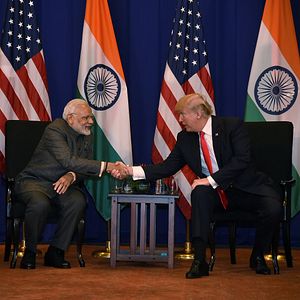On Monday, U.S. President Donald J. Trump held a bilateral meeting with Indian Prime Minister Narendra Modi on the sidelines of the Association of Southeast Asian Nations summits in Manila. The meeting is the first significant bilateral meeting between the two leaders since Trump hosted Modi in Washington, D.C., for an official visit in June.
According to a readout of the meeting released by the Trump’s press secretary, he and Modi discussed “the comprehensive strategic partnership between the United States and India and their shared commitment to a free and open Indo-Pacific region.” Their meeting took place shortly after a lower-level working group meeting of the so-called quadrilateral group of states — the United States, India, Japan, and Australia — around the same theme of a “free and open Indo-Pacific.”
The White House’s readout of the meeting added that Modi and Trump “pledged to enhance their cooperation as Major Defense Partners.” In 2016, the Obama administration elevated India to the level of a “Major Defense Partner,” a status afforded only to New Delhi that gives it access to sensitive U.S. defense technology at the same level as U.S. allies. (The status does not imply an alliance.)
Curiously, the White House added in its readout that the two leaders had resolved during their meeting that “two of the world’s great democracies should also have the world’s greatest militaries.” At first glance, that would appear to resemble Trump’s consistent pushes for U.S. arms sales — a feature of his bilateral official meetings in Japan, South Korea, and even Vietnam during this trip.
However, as the Brookings Institution’s India expert Tanvi Madan reminded me, the line echoes a paraphrase of U.S. Defense Secretary Jim Mattis’ words by U.S. Secretary of State Rex Tillerson during his October 18 speech on U.S.-India relations: “Secretary Mattis has said the world’s two greatest democracies should have the two greatest militaries. I couldn’t agree more,” Tillerson had said then.
The overt U.S. support for a “great” Indian military is a new and relatively recent feature of the bilateral relationship. It comes after Trump unveiled a new strategy for Afghanistan in late-August that was critical of Pakistan, India’s primary military rival.
Moreover, these remarks come as the United States and India operationalize the Logistics Exchange Memorandum of Agreement (LEMOA) — a U.S. tanker recently refueled an Indian Navy vessel in the Sea of Japan under the once-controversial bilateral pact. Current optics certainly suggest that an acceleration in U.S.-India defense cooperation may be around the corner, with the Trump administration more enthusiastic than ever for closer ties.

































